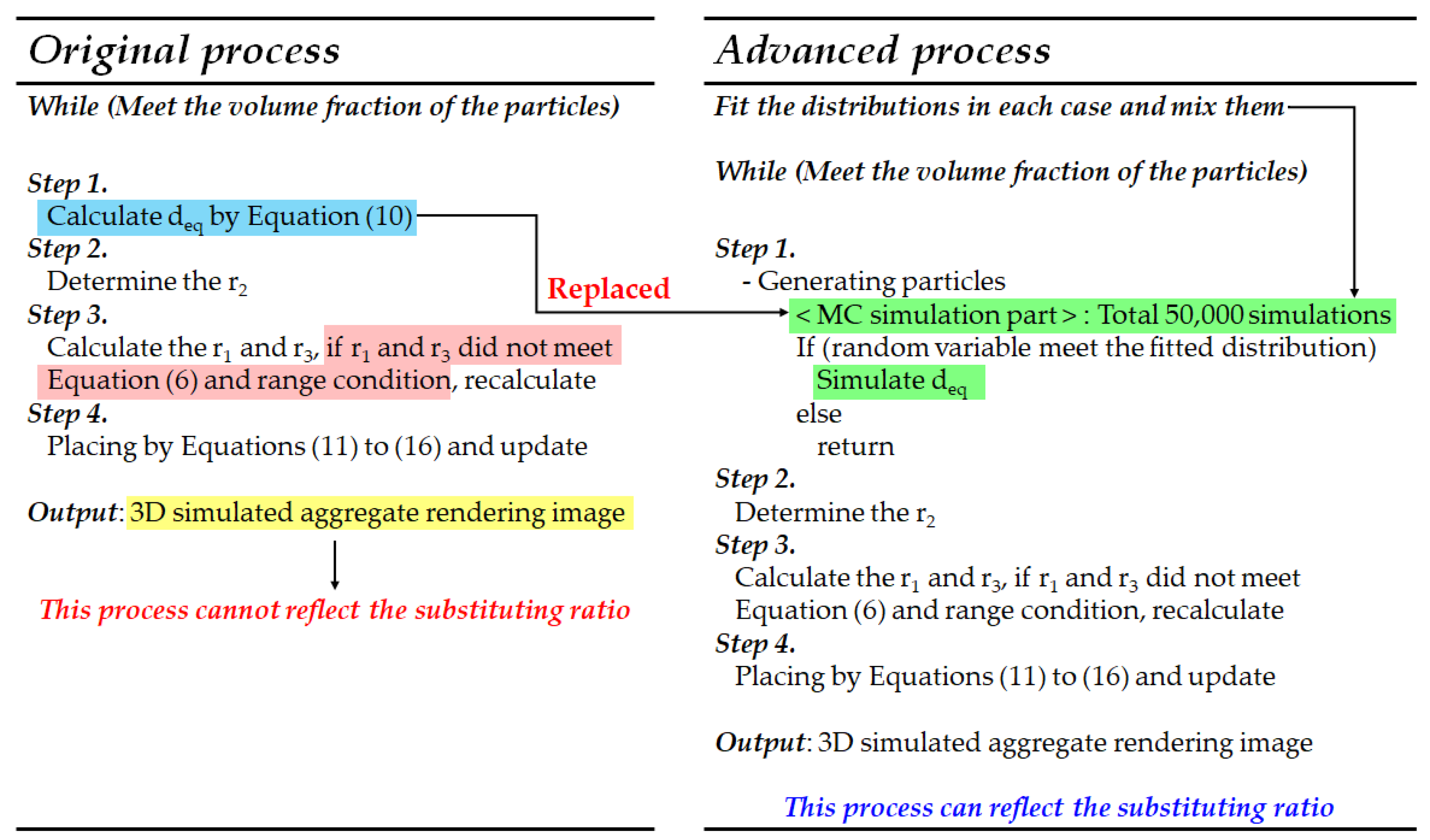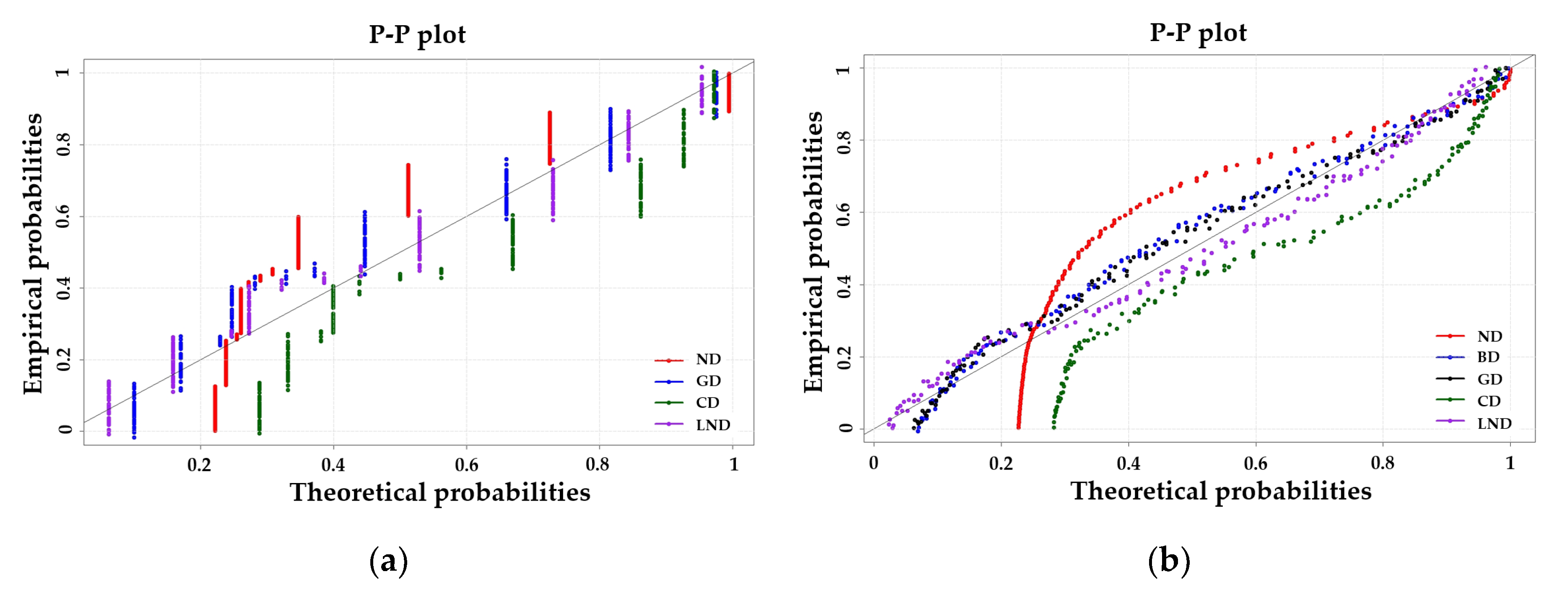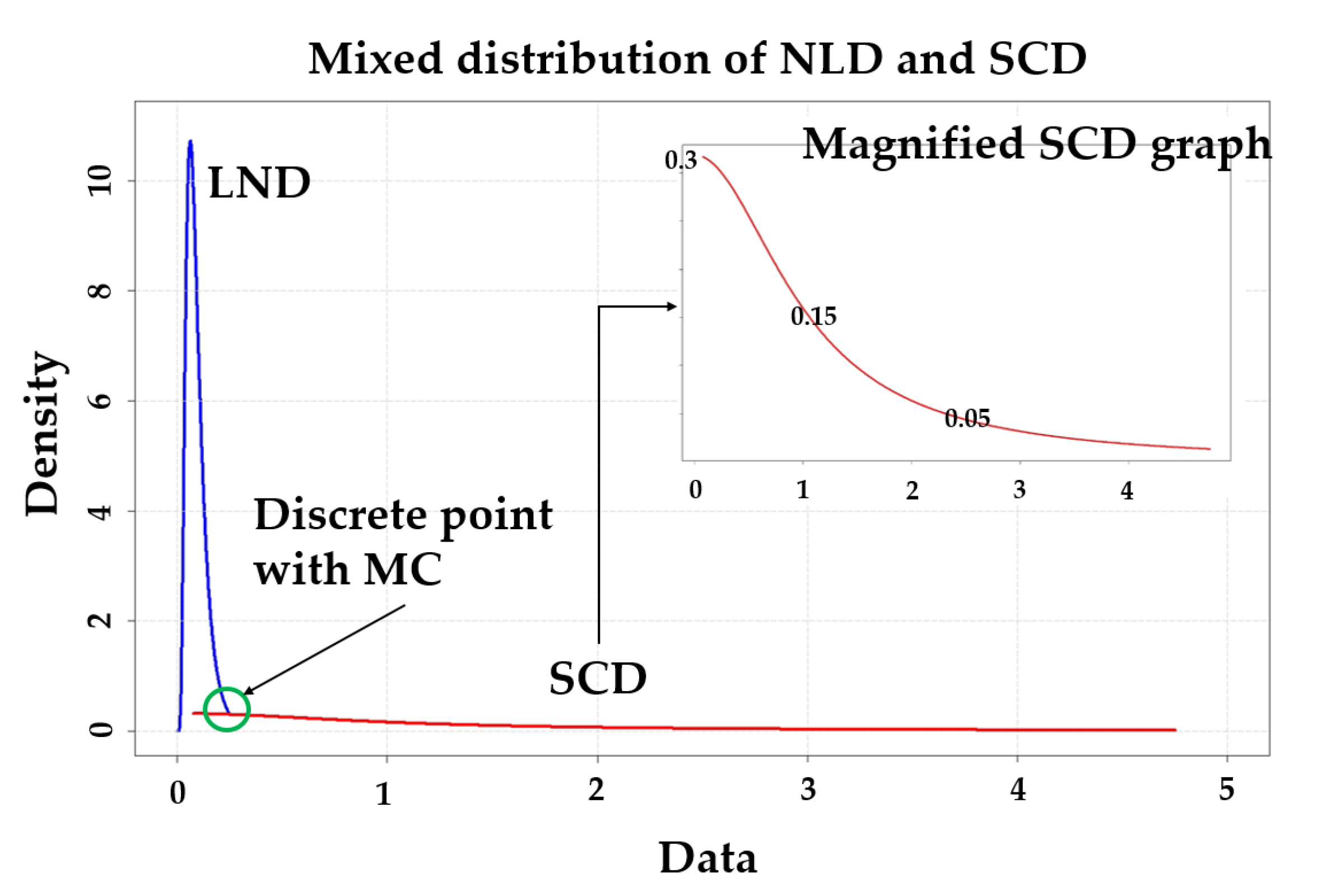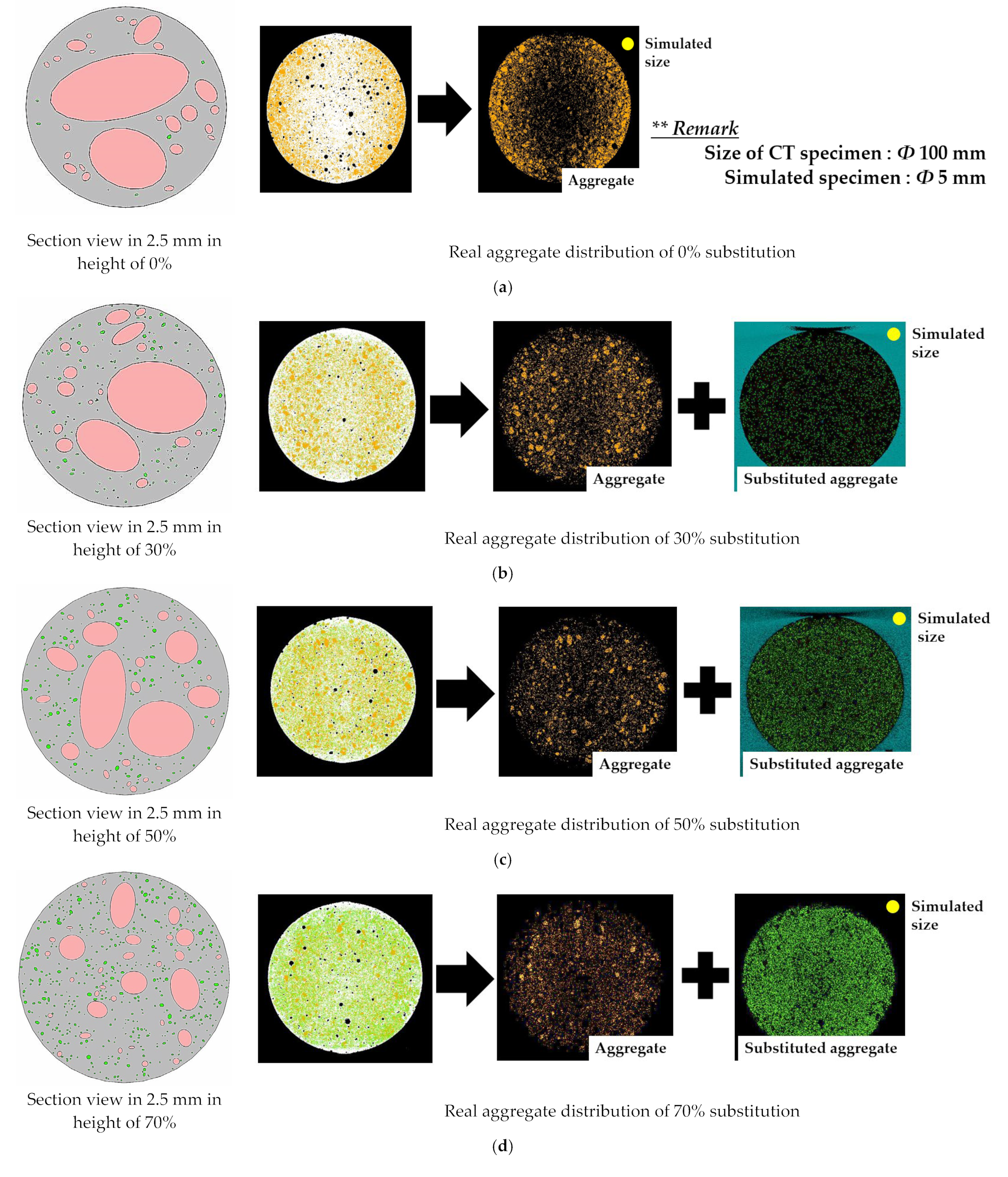Aggregate Simulation with Statistical Approach Considering Substituting
Abstract
1. Introduction
2. Data Collecting and Simulation Method
2.1. Particle Size Distribution Data of Fine Aggregates
2.2. Statistcal Fitting of the PSD Data
2.3. Aggregate Simulation
3. Results
3.1. Probability Distribution Fitting Results
3.2. Fine Aggregate Simulation Results with Simulated PSD
4. Conclusions
- The best distributions should be confirmed in order to apply the MC method. Through the fitting of the distribution, the validation works of Q–Q plot, P–P plot, and histogram were performed. From the validation, the SCD was best for natural sand and the LND was best for substituting materials. However, this is the result from an experiment; therefore, it should be focused on the process when someone follows this method, because the aggregate conditions are different case by case.
- From the simulation results, the statistical approach was reflected in the simulation well. However, a condition should be strictly kept by discretizing the mixed distribution with the MC method.
- It was demonstrated that reflecting the established mixed distribution brought realistic simulation results in the particle simulation. This was confirmed by comparing the CT results and the simulated section.
- In a further study, pore simulation should be considered. The possibility was confirmed that this study can be combined with fractal theory. The existing fractal theory showed a simple simulation method; therefore, it can be combined with this study.
Author Contributions
Funding
Institutional Review Board Statement
Informed Consent Statement
Data Availability Statement
Acknowledgments
Conflicts of Interest
Abbreviations
| Abbreviations | |
| AI | Artificial intelligence |
| BD | Beta distribution |
| GD | Gamma distribution |
| GPR | Gaussian process regression |
| LND | Log normal distribution |
| MC | Monte Carlo |
| ND | Normal distribution |
| Probability density function | |
| P–P | Probability–probability |
| PSD | Particle size distribution |
| Q–Q | Quantile–quantile |
| SCD | Standard Cauchy distribution |
| Symbols | |
| Parameter of BD and GD | |
| Equivalent diameter | |
| Largest diameter | |
| Smallest diameter | |
| Enlargement factor | |
| Flatness factor | |
| Mean of data in ND | |
| Variance of data in ND | |
| Random variable for realization with the range of 0 to 1 | |
| Principal radius of the ellipsoid | |
| Data | |
References
- Hu, Z.; Kong, Z.; Cai, G.; Li, Q.; Guo, Y.; Su, D.; Liu, J.; Zheng, S. Study of the properties of full component recycled dry-mixed masonry mortar and concrete prepared from construction solid waste. Sustainability 2021, 13, 8385. [Google Scholar] [CrossRef]
- Suchithra, S.; Jayashree, S. A review on recent developments in the recycled aggregate concrete. AIP Conf. Proc. 2021, 2387, 100001. [Google Scholar]
- Yehia, S.; Helal, K.; Abusharkh, A.; Zaher, A.; Istaitiyeh, H. Strength and durability evaluation of recycled aggregate concrete. Int. J. Concr. Struct. Mater. 2015, 9, 219–239. [Google Scholar] [CrossRef]
- Manju, K.; Kumar, D.; Kumar, N.; Kumar, S.N. Behaviour of concrete by using artificial aggregates a review. Eng. Technol. 2018, 7, 255–258. [Google Scholar] [CrossRef]
- George, G.K.; Revathi, P. Production and Utilisation of Artificial Coarse Aggregate in Concrete—A Review. In Proceedings of the IOP Conference Series: Materials Science and Engineering, Kerala, India, 14–15 July 2020; p. 012035. [Google Scholar]
- Onprom, P.; Chaimoon, K.; Cheerarot, R. Influence of bottom ash replacements as fine aggregate on the property of cellular concrete with various foam contents. Adv. Mater. Sci. Eng. 2015, 1–11. [Google Scholar] [CrossRef]
- Singh, N.; Mithulraj, M.; Arya, S. Influence of coal bottom ash as fine aggregates replacement on various properties of concretes: A review. Resour. Conserv. Recycl. 2018, 138, 257–271. [Google Scholar] [CrossRef]
- Woo, B.-H.; Jeon, I.-K.; Yoo, D.-H.; Kim, S.-S.; Lee, J.-B.; Kim, H.-G. Utilization of municipal solid waste incineration bottom ash as fine aggregate of cement mortars. Sustainability 2021, 13, 8832. [Google Scholar] [CrossRef]
- Kim, H.G.; Qudoos, A.; Jeon, I.K.; Woo, B.H.; Ryou, J.S. Assessment of PCM/SiC-based composite aggregate in concrete: Energy storage performance. Constr. Build. Mater. 2020, 258, 119637. [Google Scholar] [CrossRef]
- Woo, B.-H.; Yoo, D.-H.; Kim, S.-S.; Lee, J.-B.; Ryou, J.-S.; Kim, H.-G. Effects of thermal conductive materials on the freeze-thaw resistance of concrete. Materials 2021, 14, 4063. [Google Scholar] [CrossRef]
- Woo, B.H.; Jeon, I.K.; Yoo, D.H.; Kim, H.G.; Ryou, J.-S. Ice-melting performance assessment of cement composites using silicon carbide as fine aggregate. Appl. Therm. Eng. 2021, 194, 117113. [Google Scholar] [CrossRef]
- Jeon, I.K.; Qudoos, A.; Jakhrani, S.H.; Kim, H.G.; Ryou, J.-S. Investigation of sulfuric acid attack upon cement mortars containing silicon carbide powder. Pow. Technol. 2020, 359, 181–189. [Google Scholar] [CrossRef]
- Garboczi, E.J.; Bentz, D.P. Computer simulation and percolation theory applied to concrete. Ann. Rev. Comput. Phys. VII 1999, 85, 85–123. [Google Scholar]
- Marí, A.R. Numerical simulation of the segmental construction of three dimensional concrete frames. Eng. Struct. 2000, 22, 585–596. [Google Scholar] [CrossRef]
- Cervera, M.; Oliver, J.; Prato, T. Simulation of construction of RCC dams. I: Temperature and aging. J. Struct. Eng. 2000, 126, 1053–1061. [Google Scholar] [CrossRef]
- Achenbach, M.; Lahmer, T.; Morgenthal, G. Identification of the thermal properties of concrete for the temperature calculation of concrete slabs and columns subjected to a standard fire—Methodology and proposal for simplified formulations. Fire Saf. J. 2017, 87, 80–86. [Google Scholar] [CrossRef]
- Liu, Y.; Song, Y.; Keller, J.; Bond, P.; Jiang, G. Prediction of concrete corrosion in sewers with hybrid Gaussian processes regression model. RSC Adv. 2017, 7, 30894–30903. [Google Scholar] [CrossRef]
- Vasudevan, S.; Ramos, F.; Nettleton, E.; Durrant-Whyte, H. Gaussian process modeling of large-scale terrain. J. Field Robot. 2009, 26, 812–840. [Google Scholar] [CrossRef]
- Pérez-Cruz, F.; Van Vaerenbergh, S.; Murillo-Fuentes, J.J.; Lázaro-Gredilla, M.; Santamaria, I. Gaussian processes for nonlinear signal processing: An overview of recent advances. IEEE Signal. Process. Mag. 2013, 30, 40–50. [Google Scholar] [CrossRef]
- Wang, X.; Yang, Z.; Jivkov, A.P. Monte Carlo simulations of mesoscale fracture of concrete with random aggregates and pores: A size effect study. Constr. Build. Mater. 2015, 80, 262–272. [Google Scholar] [CrossRef]
- Peng, Y.; Chen, X.; Ying, L.; Chen, Y.; Zhang, L. Mesoscopic numerical simulation of fracture process and failure mechanism of concrete based on convex aggregate model. Adv. Mater. Sci. Eng. 2019, 1–18. [Google Scholar] [CrossRef]
- Tarighat, A.; Zehtab, B.; Tavakoli, D. An introductory review of simulation methods for the structure of cementitious material hydrates at different length scales. Pertan. J. Sci. Technol. 2016, 24, 27–39. [Google Scholar]
- Wang, X.; Zhang, M.; Jivkov, A.P. Computational technology for analysis of 3D meso-structure effects on damage and failure of concrete. Int. J. Solid. Struct. 2016, 80, 310–333. [Google Scholar] [CrossRef]
- Unger, J.F.; Eckardt, S. Multiscale modeling of concrete. Arch. Comput. Methods Eng. 2011, 18, 341–393. [Google Scholar] [CrossRef]
- Chen, T.; Xiao, S. Three-dimensional mesoscale modeling of concrete with convex aggregate based on motion simulation. Constr. Build. Mater. 2021, 277, 122257. [Google Scholar] [CrossRef]
- Fang, Q.; Zhang, J. Three-dimensional modelling of steel fiber reinforced concrete material under intense dynamic loading. Constr. Build. Mater. 2013, 44, 118–132. [Google Scholar] [CrossRef]
- Lee, E.; Ko, J.; Yoo, J.; Park, S.; Nam, J. Analysis of the aggregate effect on the compressive strength of concrete using dune sand. Appl. Sci. 2021, 11, 1952. [Google Scholar] [CrossRef]
- Mahawish, A.; Bouazza, A.; Gates, W.P. Effect of particle size distribution on the bio-cementation of coarse aggregates. Acta Geotech. 2018, 13, 1019–1025. [Google Scholar] [CrossRef]
- Jakhrani, S.H.; Kim, H.G.; Jeon, I.K.; Ryou, J.S. Effect of saturated tea waste and perlite particles on early age hydration of high-strength cement mortars. Materials 2019, 12, 2269. [Google Scholar] [CrossRef] [PubMed]
- Guan, J.; Yuan, P.; Hu, X.; Qing, L.; Yao, X. Statistical analysis of concrete fracture using normal distribution pertinent to maximum aggregate size. Theor. Appl. Fract. Mech. 2019, 101, 236–253. [Google Scholar] [CrossRef]
- Campos, J.A.G. Distributional assumptions in educational assessments analysis: Normal distributions versus generalized beta distribution in modeling the phenomenon of learning. Proc. Soc. Behav. Sci. 2013, 106, 886–895. [Google Scholar] [CrossRef][Green Version]
- Wang, J.; Zheng, W.; Zhao, Y.; Zhang, X. Prediction of concrete failure time based on statistical properties of compressive strength. Appl. Sci. 2020, 10, 815. [Google Scholar] [CrossRef]
- Balakrishnan, N.; Nevzorov, V.B. A Primer on Statistical Distributions; John Wiley & Sons: Hoboken, NJ, USA, 2004. [Google Scholar]
- Diamond, S.; Dolch, W.L. Generalized log-normal distribution of pore sizes in hydrated cement paste. J. Coll. Interface Sci. 1972, 38, 234–244. [Google Scholar] [CrossRef]
- Huang, J.; Li, W.; Huang, D.; Wang, L.; Chen, E.; Wu, C.; Wang, B.; Deng, H.; Tang, S.; Shi, Y. Fractal analysis on pore structure and hydration of magnesium oxysulfate cements by first principle, thermodynamic and microstructure-based methods. Fractal Fract. 2021, 5, 164. [Google Scholar] [CrossRef]










Publisher’s Note: MDPI stays neutral with regard to jurisdictional claims in published maps and institutional affiliations. |
© 2022 by the authors. Licensee MDPI, Basel, Switzerland. This article is an open access article distributed under the terms and conditions of the Creative Commons Attribution (CC BY) license (https://creativecommons.org/licenses/by/4.0/).
Share and Cite
Woo, B.H.; Lee, J.B.; Lee, H.; Kim, H.G. Aggregate Simulation with Statistical Approach Considering Substituting. Sustainability 2022, 14, 1644. https://doi.org/10.3390/su14031644
Woo BH, Lee JB, Lee H, Kim HG. Aggregate Simulation with Statistical Approach Considering Substituting. Sustainability. 2022; 14(3):1644. https://doi.org/10.3390/su14031644
Chicago/Turabian StyleWoo, Byeong Hun, Jeong Bae Lee, Hyunseok Lee, and Hong Gi Kim. 2022. "Aggregate Simulation with Statistical Approach Considering Substituting" Sustainability 14, no. 3: 1644. https://doi.org/10.3390/su14031644
APA StyleWoo, B. H., Lee, J. B., Lee, H., & Kim, H. G. (2022). Aggregate Simulation with Statistical Approach Considering Substituting. Sustainability, 14(3), 1644. https://doi.org/10.3390/su14031644






